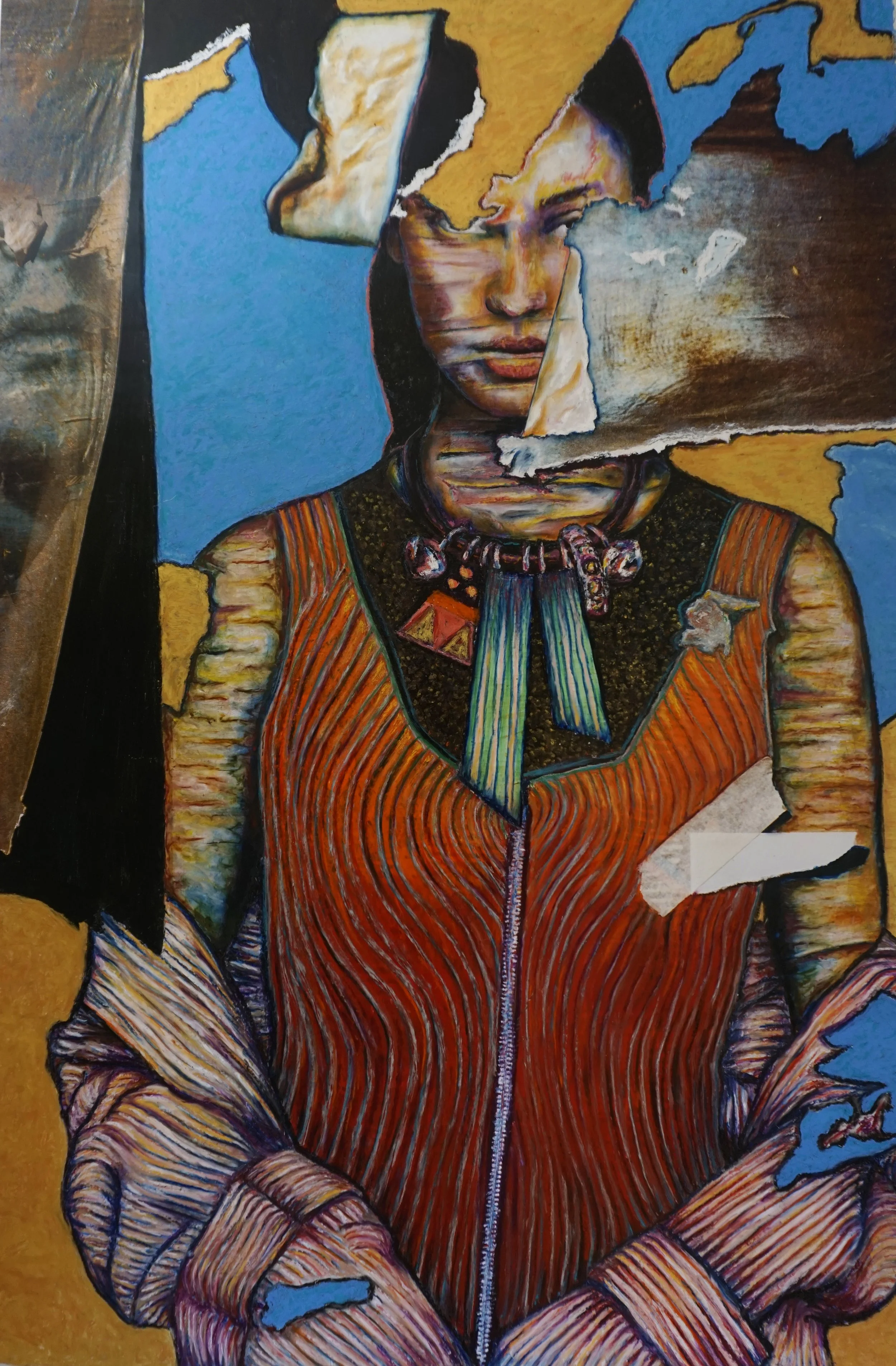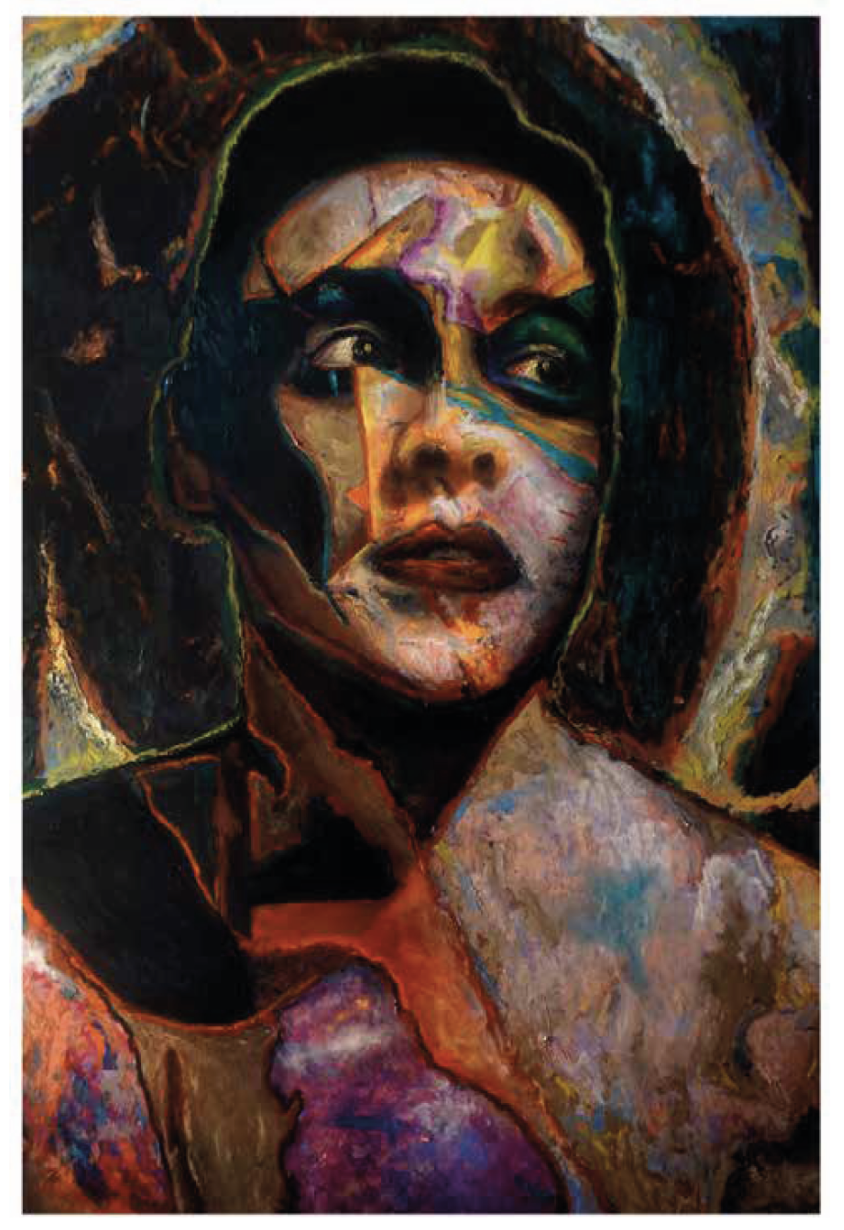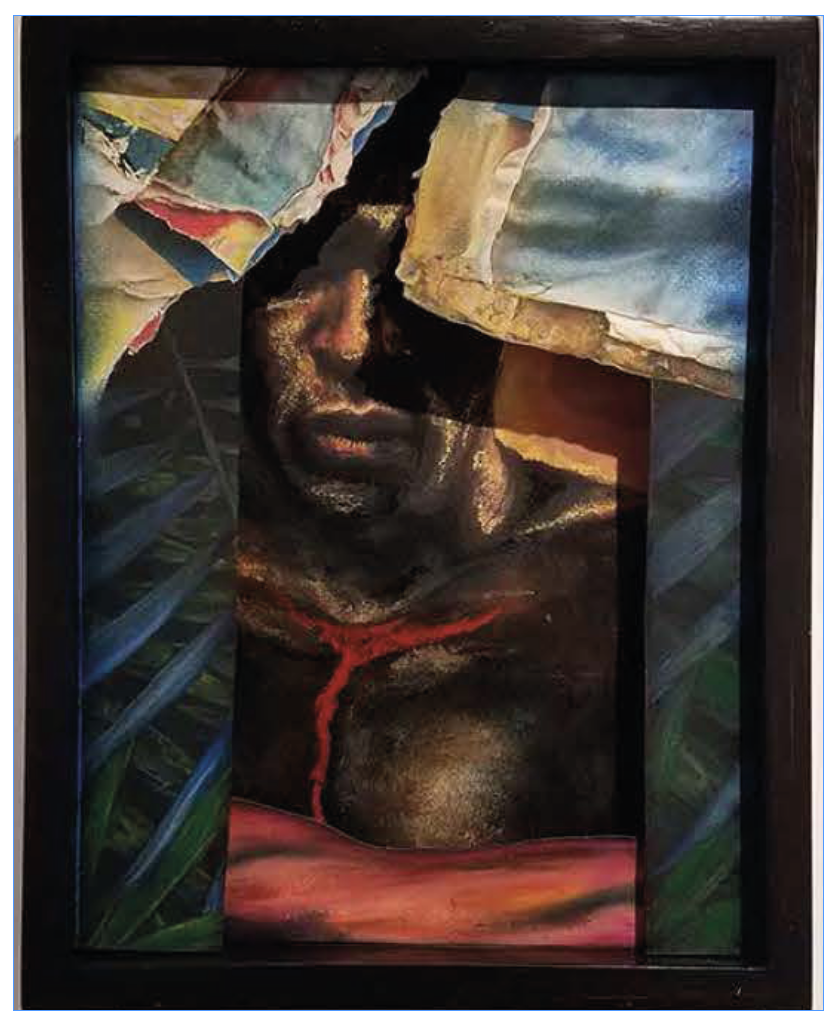Supporting Queer Art has never
been so easy.
Let the highest bid WIN!
ISupport the vibrant future of queer art! By placing a high bid, you're directly contributing to The Bureau of Queer Art's community exhibitions, publications, residencies, and cross-border projects that build and enrich our community. Remember, winning a bid is a commitment—payment must be made via a secure PayPal invoice, which can be completed using bank or credit card information within five business days. Artwork will be available for pickup from Dama Gallery in Ventura, CA, or shipped on June 2nd, 2024 at the cost of bid winner. Your generous support enables us to continue making a meaningful impact. Bid generously and support passionately!
(View Auction Item and other artworks available outside auction below - All work is unframed)
AUCTION ITEM
Sergio & Bacus, 2020
Oil pastel, marker, ink, acrylic, varnish, and resin
47 3/5 × 72 × 1/10 in, 121 × 183 × 0.2 cm - unframed
1850 USD - Estimated Value
Shadow Work, 2022
Oil pastel, marker, ink, acrylic,
varnish, and resin
12 × 18 inches
$750 USD Available in Gallery - Please Contact
Joan of Arc, 2021
Oil pastel, marker, ink, acrylic,
varnish, and resin
47 3/5 × 72 × 1/1 0 in
121 × 183 × 0.2 cm
$1450 USD Framed
25000 Pesos en Marco
Queer Saints, St Sebastian
Oil Pastels, mixed media
22 x 28 inches en marco
1150 USD - Available in Gallery - Please Contact
Queer Saints, Bacchus & Sirius #2
This is a 3D box layered, and painted on cotton paper.
10 x 14 in - 3in depth
$550 USD | SOLD
Queer Saints, St. Sebastian #2
30 x 30 cm
650 USD | SOLD
Joan of Arc - study, 2020
Oil pastel, marker, ink, acrylic, varnish, and resin
23 × 32 × 1/10 in
$950 USD - Available in Gallery - Please Contact
AUCTION ITEM
Sergio & Bacus, 2020
Oil pastel, marker, ink, acrylic, varnish, and resin
47 3/5 × 72 × 1/10 in, 121 × 183 × 0.2 cm - unframed
1850 USD - Gallery Price
Study Joan of Arc
Oil Pastel on paper
24 x 32 inches
This piece is part of the Queer Saints series.
1150 USD - Available in Gallery - Please Contact
Stroke of Insight #6, #1, #2, #3, #4.
34 inches diameter, 3 inches depth,
Mixed media oil pastels
Not for sale - series in progress
LA iNTERVENCiÓN DEL ALQUiMiSTA QUEER: UN ViAJE DE TRANSFORMACiÓN EN EL ARTE Y LA
COMUNiDAD
ARTiSTA @THEQUEERALCHEMiST
En las bulliciosas y animadas calles de la Ciudad de México, donde los ecos de la historia se mezclan con el ritmo de la vida moderna, Micheal Swank, conocido como ‘El Alquimista Queer’, emerge como una fuerza transformadora en el mundo del arte contemporáneo. Swank, un artista y director de Art Gallery Studios, se ha establecido no solo a través de su visión artística única, sino también a través de su profundo impacto en la comunidad de arte queer. Su viaje personal, marcado por batallas contra el VIH y el aislamiento, lo ha impulsado a crear un santuario para artistas queer, donde el sentido de comunidad y la experiencia compartida triunfan sobre las sombras de la soledad.
El proceso artístico de Swank es una exploración ritualista del alma de la ciudad. Equipado con una cámara, cuchillos, rasquetas, agua embotellada, trementina, trapos y pigmentos, se aventura por las calles, interactuando con la ciudad como un lienzo vivo. Las paredes de la Ciudad de México, cubiertas de anuncios de papel, se convierten en su material de origen. Estos papeles no son meros objetos efímeros; son artefactos antropológicos que capturan momentos específicos en la narrativa cultural de la ciudad. Contienen historias no contadas, cambiantes y evolucionan a medida que las capas se superponen, formando un rico palimpsesto de historia e identidad.
Este proceso de revelación se asemeja a un lento baile, una revelación metódica de las historias enterradas bajo la superficie. Swank desgarra cuidadosamente estas capas, cada rasgadura descubre un fragmento de la narrativa, cada lágrima lo acerca a las historias ocultas. A medida que trabaja, las imágenes y los textos se mezclan, formando una sinfonía de color y textura. Este es el momento de la alquimia, donde las voces olvidadas de la comunidad queer comienzan a resonar una vez más.
Al descubrir la historia, Swank transporta cuidadosamente sus materiales encontrados de regreso a su estudio. Allí, el proceso de transformación continúa. Cada capa se retira meticulosamente, se examina y se conserva. Integra barnices, pinturas, tintas, pasteles al óleo y otros materiales, transformando el frágil papel en un lienzo vibrante. Este proceso artístico es un testimonio de la preservación, dando permanencia a lo efímero y una voz a lo que una vez fue silenciado.
En su innovadora serie ‘Santos Queer’, Micheal Swank explora profundamente las narrativas a menudo borradas de la existencia queer, desenterrando e iluminando las historias que la sociedad ha silenciado o distorsionado históricamente. Esta serie no es solo un esfuerzo artístico; es una declaración profunda sobre la naturaleza de la aceptación cultural y la lucha a menudo invisible por preservar una identidad auténtica dentro de la comunidad queer.
El arte de Swank confronta y desafía las normas sociales que durante mucho tiempo han dictado la narrativa de la existencia queer. Saca a la luz las historias de la no conformidad de género, el amor queer y el desamor, relatos que a menudo se pasan por alto o se alteran para encajar en las versiones más aceptables y convencionales de lo que la sociedad considera aceptable. En la cultura dominante, existe una tendencia a limpiar las complejidades de la vida queer, suavizando los bordes que no se ajustan a las expectativas convencionales. El trabajo de Swank desafía esta limpieza, presentando estas narrativas en su forma auténtica y sin filtro.
Su serie ‘Santos Queer’ es un acto radical de recuperación, una forma de abrazar el espectro completo de la experiencia queer, incluyendo sus defectos y complejidades. Los sujetos de Swank no son idealizados ni simplificados; se representan en su totalidad, encarnando la rica tela de la experiencia humana. Este enfoque desafía al espectador a enfrentar la realidad a menudo incómoda de que en nuestra cultura, para ser aceptados, los aspectos únicos y crudos de las identidades individuales a menudo se suprimen u ocultan.
El arte de Swank pide a la audiencia que considere cómo la cultura a menudo exige a las personas que silencien sus verdaderos seres para encajar en una estrecha definición de aceptabilidad. Destaca el conflicto interno que muchos enfrentan: suprimir partes de su identidad para ser aceptados mientras luchan con la pérdida de autenticidad que esto implica. Su trabajo es un comentario conmovedor sobre la presión social de usar máscaras que nos protegen de las realidades de nuestra propia humanidad. Al exponer las verdades sin adornos de sus sujetos, Swank invita a los espectadores a reflexionar sobre sus propias fachadas y los aspectos de sí mismos que han oscurecido en la búsqueda de la aceptación social.
La serie ‘Santos Queer’ también aborda la naturaleza inherentemente humana de cometer errores. Swank sugiere que errar no solo es humano, sino una parte integral de nuestro viaje hacia el éxito. Contrariamente a la narrativa cultural predominante que celebra la perfección y rechaza el fracaso, su arte postula que reconocer y aceptar nuestros errores es vital. Esta aceptación no se representa como una resignación pasiva, sino como un compromiso activo con nuestro ser completo, incluyendo nuestras fallas y errores.
Además, el trabajo de Swank extiende una invitación compasiva a los espectadores: abrazar la compasión por uno mismo al mismo tiempo que asumen la responsabilidad de nuestras acciones dentro de un contexto más amplio. Su arte reconoce la compleja interacción entre la identidad personal y las normas sociales, instando a un equilibrio entre la auto-compasión y la responsabilidad. Es un llamado a reconocer que nuestras acciones y elecciones, incluso aquellas que se desvían de las expectativas sociales, contribuyen al rico mosaico de nuestras experiencias individuales y colectivas.
En esencia, la serie ‘Santos Queer’ es una profunda exploración de lo que significa ser auténticamente humano en un mundo que a menudo exige conformidad y perfección. A través de su arte, Micheal Swank no solo celebra la diversidad y la
complejidad de las narrativas queer, sino que también nos desafía a reconsiderar nuestras percepciones de identidad, aceptación y la verdadera naturaleza de la celebración cultural. Su trabajo se erige como un poderoso testimonio de la belleza y la resistencia del espíritu queer, abrazando sin reservas cada faceta de la experiencia humana.
Su serie ‘Trabajo de Sombra’ extiende esta introspección. En estos autorretratos, Swank dirige la lente hacia adentro, explorando las partes de su identidad que a menudo pasan desapercibidas u ocultas. Las sombras sociales que se proyectan se enfocan intensamente, iniciando un diálogo sobre los aspectos de nosotros mismos que a menudo ignoramos o ocultamos.
El arte de Swank trasciende la mera representación; es una profunda exploración de la condición humana. Sus obras no son simplemente imágenes; son historias tridimensionales de pecado, redención y la búsqueda de la aceptación. Resonan no solo con la comunidad queer, sino con cualquier persona que alguna vez se haya sentido marginada o incomprendida.
Más allá de su obra de arte, el papel de Swank como Director de Art Gallery Studios es fundamental. Ha creado un refugio donde los artistas queer y aliados pueden encontrar solidaridad, apoyo e inspiración. Esta iniciativa es particularmente significativa en un mundo que a menudo aísla a las personas, especialmente aquellas que luchan contra enfermedades como el VIH y la salud mental. El estudio de Swank se erige como un faro de comunidad y pertenencia.
En su estudio y dentro de la comunidad, Micheal Swank emerge como un visionario intervencionista, su trabajo se extiende mucho más allá de los límites de la artesanía tradicional. Su enfoque es de transformación alquímica, donde los materiales encontrados e historias aparentemente dispares se entrelazan en una narrativa cohesiva y significativa. Swank posee una rara capacidad para percibir el potencial inherente tanto en las personas como en los materiales, visualizando y materializando las formas en que pueden interconectarse y resonar.
La artesanía de Swank es un juego dinámico de descubrimiento y creación, un diálogo constante entre el artista y los elementos que emplea. Recoge lo pasado por alto, lo desechado y lo mundano, viendo en ellos no solo su pasado o estado actual, sino también sus futuras posibilidades. Su proceso creativo se asemeja a una danza de transformación, donde cada paso es un acto deliberado de reclamación y reinterpretación.
A través de este proceso, Swank nos desafía a reevaluar las historias que nos han contado y las que perpetuamos. Nos insta a mirar más allá de la superficie, a cuestionar las narrativas que nos han transmitido y a encontrar los hilos ocultos de verdad y significado dentro de ellas. Su arte se convierte en un poderoso testimonio de las complejidades y la rica diversidad de las vidas queer, desenredando las narrativas monolíticas a menudo retratadas en la cultura dominante.
El trabajo de Swank en la comunidad amplifica este impacto. No es solo un artista en su estudio, sino también un catalizador de cambio en la sociedad en general. Su papel intervencionista lo lleva a interactuar con diversas personas y grupos, reuniéndolos en un viaje creativo compartido. Esta colaboración no se trata solo de crear arte; se trata de fomentar la comprensión, la empatía y una reimaginación colectiva de lo que puede ser.
En esencia, Micheal Swank hace más que simplemente reclamar narrativas; les insufla nueva vida, infundiéndoles profundidad, dignidad y una rica diversidad. Su enfoque es una celebración de la naturaleza multifacética de la experiencia humana, y a través de su trabajo, nos invita a todos a abrazar las innumerables historias que componen nuestro mundo. Su arte es un recordatorio de que en el tapiz de la vida, cada hilo, por insignificante que parezca, contribuye a la belleza y complejidad del conjunto.
THE QUEER ALCHEMiST’S INTERVENTiON: A JOURNEY OF TRANSFORMATiON iN ART AND COMMUNiTY
@THEQUEERALCHEMiST
In the bustling, lively streets of Mexico City, where the echoes of history blend with the rhythm of modern life, Micheal Swank, known as ‘The Queer Alchemist,’ emerges as a transformative force in the world of contemporary art. Swank, an artist and the director of Art Gallery Studios, has established himself not just through his unique artistic vision but also through his profound impact on the queer art community. His personal journey, marked by battles with HIV and isolation, has propelled him to create a sanctuary for queer artists, where the sense of community and shared experience triumphs over the shadows of solitude.
Swank’s artistic process is a ritualistic exploration of the city’s soul. Equipped with a camera, knives, scrapers, bottled water, turpentine, rags, and pigments, he ventures into the streets, engaging with the city as a living canvas. The walls of Mexico City, layered with paper advertisements, become his source material. These papers are not mere ephemera; they are anthropological artifacts capturing specific moments in the city’s cultural narrative. They hold within them untold stories, changing and evolving as layers overlap, forming a rich palimpsest of history and identity.
This process of revelation is akin to a slow dance, a methodical uncovering of the stories buried beneath the surface. Swank carefully tears apart these layers, each rip uncovering a fragment of the narrative, each tear bringing him closer to the hidden stories. As he works, the images and texts blend, forming a symphony of color and texture. This is the moment of alchemy, where the forgotten voices of the queer community begin to resonate once more.
Upon discovering the story, Swank carefully transports his found materials back to his studio. There, the transformation process continues. Each layer is meticulously removed, examined, and preserved. He integrates varnish, paints, inks, oil pastels, and other materials, transforming the fragile paper into a vibrant canvas. This artistic process is a testament to preservation, giving permanence to the ephemeral, and a voice to the once voiceless.
In his groundbreaking ‘Queer Saints’ series, Micheal Swank explores deep into the often-erased narratives of queer existence, unearthing and illuminating the stories that society has historically muted or distorted. This series is not just an artistic endeavor; it’s a profound statement on the nature of cultural acceptance and the often-unseen struggle to preserve authentic identity within the queer community.
Swank’s art confronts and challenges the societal norms that have long dictated the narrative of queer existence. He brings to light the stories of gender non-conformity, queer love, and heartbreak—tales that are often glossed over or altered to fit into the more palatable, mainstream versions of what society deems acceptable. In mainstream culture, there’s a tendency to sanitize the complexities of queer life, smoothing out the edges that don’t align with conventional expectations. Swank’s work stands in defiance of this sanitization, presenting these narratives in their authentic, unfiltered form.
His ‘Queer Saints’ series is a radical act of reclamation, a way of embracing the full spectrum of queer experience, including its flaws and complexities. Swank’s subjects are not idealized or simplified; they are depicted in their entirety, embodying the rich tapestry of human experience. This approach challenges the viewer to confront the often-uncomfortable reality that in our culture, to gain acceptance, the unique and raw aspects of individual identities are frequently suppressed or hidden.
Swank’s art asks the audience to consider how culture often requires individuals to mute their true selves in order to fit into a narrow definition of acceptability. He highlights the internal conflict many face—suppressing parts of their identity to gain acceptance while grappling with the loss of authenticity that this entails. His work is a poignant commentary on the societal pressure to wear costumes that shield us from the realities of our own humanity. By exposing the unvarnished truths of his subjects, Swank invites viewers to reflect on their own facades and the aspects of themselves they have obscured in the pursuit of societal acceptance.
The ‘Queer Saints’ series also touches on the inherently human nature of making mistakes. Swank suggests that to err is not just human but an integral part of our journey towards success. Contrary to the prevailing cultural narrative that celebrates perfection and shuns failure, his art posits that acknowledging and accepting our errors is vital. This acceptance is not portrayed as a passive resignation but as an active engagement with our full selves, including our flaws and missteps.
Moreover, Swank’s work extends a compassionate invitation to viewers: to embrace compassion for oneself while simultaneously taking responsibility for our actions within a larger context. His art acknowledges the complex interplay between personal identity and societal norms, urging a balance between self-compassion and accountability. It’s a call to recognize that our actions and choices, even those that deviate from societal expectations, contribute to the rich mosaic of our individual and collective experiences.
In essence, the ‘Queer Saints’ series is a profound exploration of what it means to be authentically human in a world that often demands conformity and perfection. Through his art, Micheal Swank not only celebrates the diversity and complexity of queer narratives but also challenges us to reconsider our perceptions of identity, acceptance, and the true nature of cultural celebration. His work stands as a powerful testament to the beauty and resilience of the queer spirit, unapologetically embracing every facet of human experience.
His ‘Shadow Work’ series extends this introspection. In these self-portraits, Swank turns the lens inward, exploring the parts of his identity that are often overlooked or hidden. The societal shadows that are cast are brought into sharp focus, initiating a dialogue about the aspects of ourselves we often ignore or conceal.
Swank’s art transcends mere portrayal; it is a deep exploration of the human condition. His works are not simply images; they are three-dimensional stories of sin, redemption, and the quest for acceptance. They resonate not just with the queer community but with anyone who has ever felt marginalized or misunderstood.
Beyond his artwork, Swank’s role as the Director of Art Gallery Studios is pivotal. He has created a haven where queer and allied artists can find solidarity, support, and inspiration. This initiative is particularly significant in a world that often isolates individuals, especially those grappling with illnesses like HIV and mental health. Swank’s studio stands as a beacon of community and belonging.
In his studio and within the community, Micheal Swank emerges as a visionary interventionist, his work extending far beyond the bounds of traditional artistry. His approach is one of alchemical transformation, where found materials and stories, seemingly disparate, are woven into a cohesive and meaningful narrative. Swank possesses a rare ability to perceive the inherent potential in both people and materials, envisioning and actualizing the ways in which they can interconnect and resonate.
Swank’s artistry is a dynamic interplay of discovery and creation, an ongoing dialogue between the artist and the elements he employs. He gathers the overlooked, the discarded, and the mundane, seeing in them not just their past or present state, but their future possibilities. His creative process is akin to a dance of transformation, where every step is a deliberate act of reclamation and reinterpretation.
Through this process, Swank challenges us to re-evaluate the stories we have been told and the ones we perpetuate. He urges us to look beyond the surface, to question the narratives handed down to us, and to find the hidden threads of truth and meaning within them. His art becomes a powerful testament to the intricacies and rich diversity of queer lives, unraveling the monolithic narratives often portrayed in mainstream culture.
Swank’s work in the community amplifies this impact. He is not just an artist in his studio but also a catalyst for change in the wider society. His interventionist role sees him engaging with various individuals and groups, bringing them together in a shared creative journey. This collaboration is not just about creating art; it’s about fostering understanding, empathy, and a collective reimagining of what can be.
In essence, Micheal Swank does more than simply reclaim narratives; he breathes new life into them, infusing them with depth, dignity, and a rich diversity. His approach is a celebration of the multifaceted nature of human experience, and through his work, he invites us all to embrace the myriad stories that make up our world. His art is a reminder that in the tapestry of life, every thread, no matter how seemingly insignificant, contributes to the beauty and complexity of the whole.



